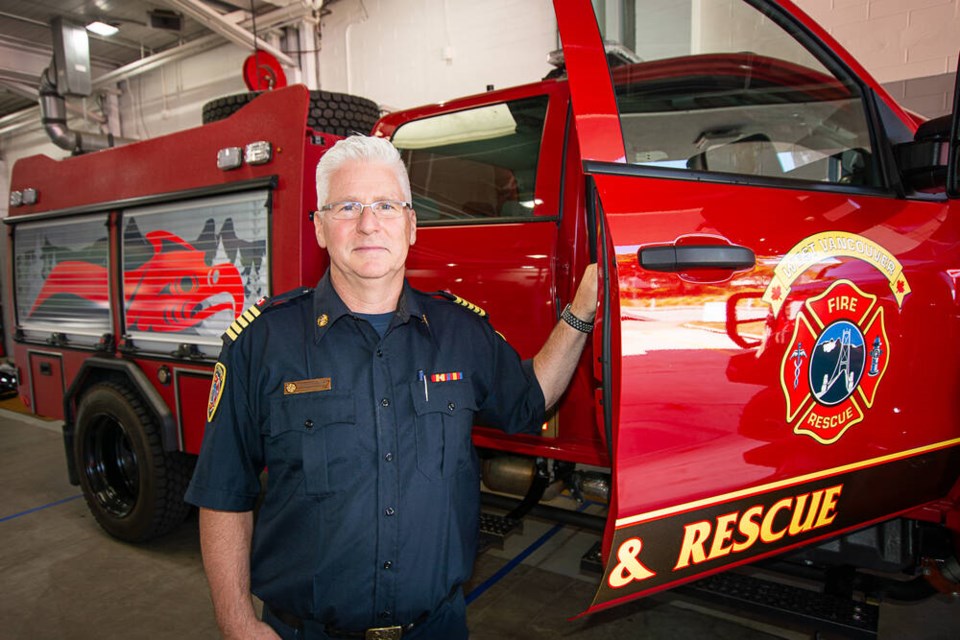West Vancouver is rolling out two new trucks that will help crews knock down fires in the district’s sprawling wildland interface.
Last Thursday, West Vancouver Fire & Rescue unveiled two Type 5 wildland fire trucks, which come equipped with hundreds of litres of water on board and “pump and roll” firefighting technology attached to the vehicle; as well as high-powered mobile pumps, hoses and bladders that hold thousands more litres of H20 to battle blazes in difficult-to-reach places.
Fire departments evolve over time as risks change, said Fire Chief Gord Howard.
Previously, West Van had no swiftwater equipment, and would find themselves knee deep in a challenging environment without proper training and equipment. So in the ’90s they got swiftwater suits and started an education program. Now the department has a rapid deployment craft to respond to swiftwater rescues.
“Just like that evolution, the wildfire risk has changed,” Howard said.
In 2018 and 2019, the department put together a wildfire plan that led to the district procuring structure protection units, which create a humidity bubble during wildfires, protecting up to 30 homes from ember showers, he said.
One event in particular raised the alarm for Howard: the wildfire that ripped through a hectare of forest and brush above Horseshoe Bay in 2023.
At the time, West Van didn’t have wildfire trucks, so some were brought in by District of North Vancouver Fire and Rescue Services.
“It was a much more effective extinguishment of the fire and managing of the fire,” Howard said. “And so we were like, ‘If we had those trucks, we would have probably dealt with it in a more expedient way.…’ Fires double in size every minute, so you really want to get on it quickly, if you can.”
After recognizing that gap in the district’s wildfire response capabilities, the department began the process of procuring the new trucks.
Massive water bladders allow precise forest firefighting
Each of the Type 5 wildland fire trucks cost around $600,000. They’re big enough to carry firefighting equipment and a crew, but nimble enough to travel through a rough woodland environment.
On the outside, the trucks are decorated with decals from Sḵwx̱wú7mesh Úxwumixw (Squamish Nation) artist Xwalacktun, depicting the Twin Sisters mountain peaks and a Thunderbird to protect the region.
Inside, each vehicle carries 500 litres of water and an onboard pump.
“You can do what we call ‘pump and roll,’ which means you can start it up, engage the pump, and as you’re driving, we have a joystick in the cab, and we can spray the fire as we’re moving,” Howard said.
Because there are no hydrants in the forest, the trucks also carry large bladders that can hold 6,800 litres of water. They can be filled by helicopters, or pumped full from nearby water sources.
Some people might ask, why don’t the helicopters just dump the water on the fire?
“They would often do that,” Howard said. “But if we fill the bladder, we can be a lot more precise, depending on how big the fire is.”
But when it comes to reducing the risk of wildfires, all this technology pales in comparison to what prevention measures can do, he said.
In communities that live so close to lush forests, prevention includes making your property more resilient to fire risk, and making sure not to start a fire yourself.
“Be safe when you’re out in the interface and around your house,” Howard said. “In a house that’s abutting the interface, that’s where a lot of the fires are caused.”
In the coastal rainforest, it’s far more likely for humans to cause fires than lightning, he said
“If you do have a fire, call us, let us know that you’re seeing fire or smoke, and we’ll get there and deal with it. Even if you think the fire's out ... call us. We want to know about it,” Howard said. "We will go check it out and make sure it’s well out."
“You hear about the holdover fires up north – they can stay active for years if they’re not really put out quickly. And the best thing for us is to get that call and get the trucks there and have crews on it and put water on it,” he said. “The trucks are a great tool, but prevention is the best tool.”
[email protected]
twitter.com/nick_laba
@nicklaba.bsky.social
 Want to stay updated on North Vancouver and West Vancouver news? Sign up for our free daily newsletter.
Want to stay updated on North Vancouver and West Vancouver news? Sign up for our free daily newsletter.




